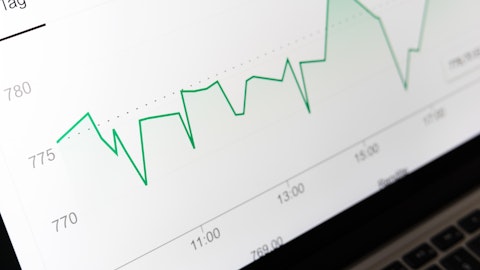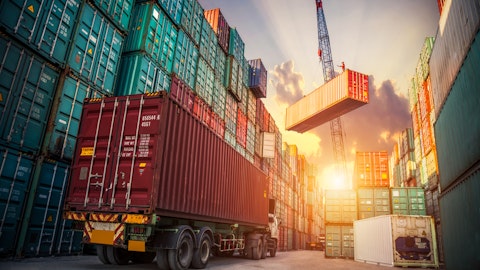This strategic move is anticipated to further enhance our interest margin profile and improve the overall structure of our debt. On the interest expense front, we did see an increase compared to the previous year, which was driven by the increased reference rate despite the sharp decrease achieved in the interest margin of our facilities. We expect this cost to decrease in the coming quarters following the anticipated interest rate cuts from the central banks. Moving on to slide nine, we highlight our great potential for profitability in 2024. We anticipate a significant increase in EBITDA compared to 2023, even if BCI rates average to the figures in 2023. If the current FFA curve materializes, our EBITDA profitability could be remarkable, reaching close to $115 million.
It’s worth mentioning that in 2023, our overall premium over the BCI for our fleet improved, reflecting our investments in the energy efficiency of our vessels and our effective commercial strategy. In addition, we have fixed almost 60% of fleet days for the second quarter at an average rate of approximately $28,300. In summary, we remain optimistic about our profitability in 2024 and our overall liquidity, affirming our ability to continue rewarding our shareholders while enhancing the composition of our fleet. This concludes my review. I will now turn the call back to Stamatis who will discuss the market and industry fundamentals. Stamatis?
Stamatis Tsantanis: Thank you, Stavros. Let’s move to slide number 10. Despite the gloomy predictions for 2023, ton-mile demand for the year was actually 6% higher as compared to 2022. That resulted in a much greater number of cargos of iron ore, coal and bauxite that exceeded an incremental of 170 million tons. As we repeated in our previous discussions, the freight rate volatility of the year was driven mainly by the effective supply of vessels during the year. Since the start of the fourth quarter of 2023, the Capesize market has strengthened considerably, which was carried forward into the Q1 of 2024. This has led to the strongest BCI average rate in more than a decade. This positive effect has also been apparent in asset prices, with Capesize values arising since the end of the third quarter between 20% and even 40%, depending on the vintage and individual vessel specifications.
Moving on to slide 11. In the current year, our outlook remains very positive. The recovery in global manufacturing, as well as extensive infrastructure investments, may drive further growth in seaborne trade of raw materials. With the expectation of a gradually lower interest rate environment, manufacturing and infrastructure investments will continue to flourish. Overall, 2024 ton-mile demand growth for Capesize cargoes is expected to be about 3.5% to 4% increase and given the current momentum, positive demand growth is likely to continue into 2025 with projected ton-mile growth of around 2.5%. Moving on to slide 12. Turning to vessel supply, in deadweight terms the order book for Capesize vessels currently stands at about the same levels of 2004, 20 years back, while replacement needs have grown considerably since then due to stringent environmental regulations.
Overall net Capesize fleet growth is expected at around 2.5% in 2024 and 1.5% in 2025, both lower than the respective ton-mile demand growth in nominal figures. Beyond the low order book, fleet efficiency has returned to historical average levels, which suggests that effective fleet supply is unlikely to grow further, except for short-term events. Capesize vessel’s peak has already fallen in the past decade from about 12-12.5 to approximately 10.5-11 knots. Strong dry bulk markets in the past years have not resulted in speed increases and we believe that this trend is sustainable due to the implementation of CII, EEXI and other regulations that will affect the efficiency of the vessels. To close today’s call, we want to emphasize that we are executing a clear strategy that includes rewarding shareholders through capital returns, investing in our fleet to drive growth and efficiencies and maintaining a strong balance sheet.
The actions we have taken to grow our fleet substantially over the past three years with quality assets and strengthen our financial position have placed Synergy in a prime position to benefit from a healthy freight market as the Capesize segment enjoys the best demand and supply fundamentals in the dry bulk space. As a result, we expect to generate significant cash flows that will facilitate further shareholder value creation moving forward. This concludes our remarks and I would like to turn the call back to the operator and answer any questions you may have. Operator, please take the call. Thank you.
Operator: Thank you. [Operator Instructions] And the questions come from the line of Tate Sullivan from Maxim Group. Please answer your question. Your line is opened.
Tate Sullivan: Great. Thank you for taking my question. First, it’s great to see the special dividend. I did not anticipate that. Just for modeling purposes, when is that payable, the special dividend and the quarterly dividend you just announced? Please, is it this quarter?
Stamatis Tsantanis: Hello, Tate. Good morning. How are you?
Tate Sullivan: Good morning. Great. Thank you. Thank you very much.
Stamatis Tsantanis: Well, as we have stated, it’s going to be payable approximately on the 10th of April. As we have stated.
Tate Sullivan: Thank you. And then also the Capesize acquisition, the 2013 bill, shifted $34 million, seems roughly in line with acquisitions in the last couple of years. Has it been? Have you seen a good deal flow recently, before the recent rally? Can you talk about the S&P market a bit?
Stamatis Tsantanis: The answer is yes. We have seen a big inflow, a big activity of transactions the last few weeks. People are buying a lot of Capes, and we have seen older ships and the inferior to the ones that we have been purchasing, being sold at very firm values. So we strongly believe, if we compare this particular acquisition with the recent precedents that we have experienced in the market, that it stands in a very, very advantageous position. So the answer is yes, of course.
Tate Sullivan: And can you talk about how much leverage you might add for that ship acquisition and the loan to value ratio for the whole fleet currently, or after the recent escalation in values that you’ve seen?



